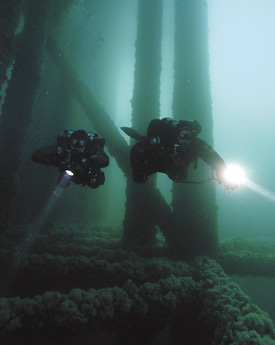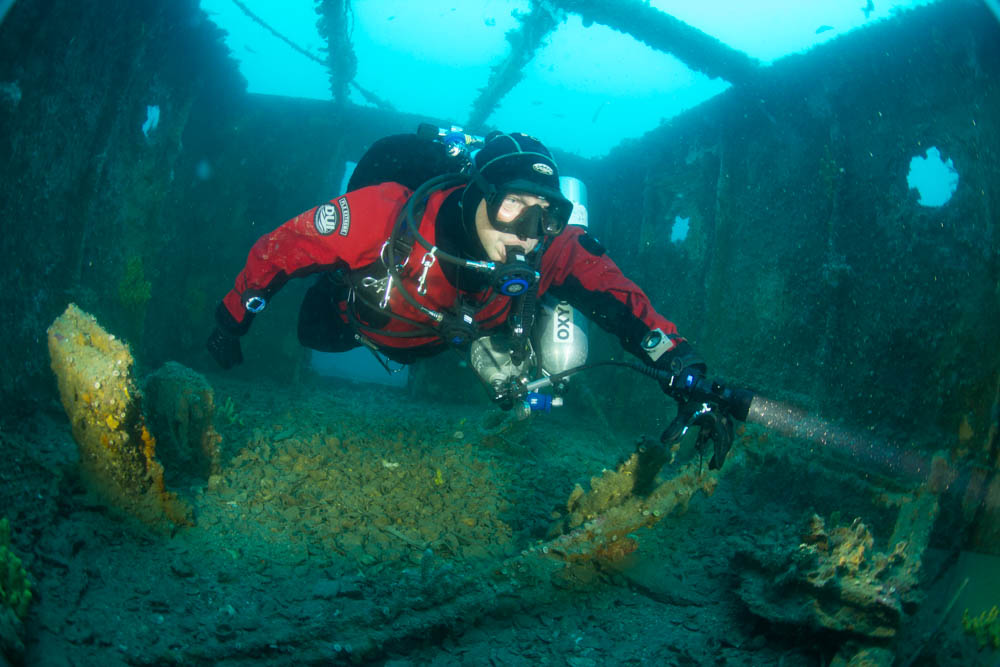Proper Weighting When Scuba Diving
I frequently get asked how much weight a diver will need for diving a particular equipment configuration. It seems like an easy question, but not many people are aware of how to select equipment, and then how to choose the proper weighting for that configuration.

Most people will be familiar with the concept of carrying enough weight to hold a short stop at 6m/20ft, with very little gas in their cylinders, and with an empty buoyancy compensator. This allows a diver to hold a decompression or safety stop in the event of having run out of gas. It essentially identifies the minimum amount of weight needed to conduct the dive.
This approach is designed to be correct at the end of the dive. This is an important aspect of the weighting process, but sadly this is where most divers stop their process. There is a bit more to it.
What about at the Start of the Dive?
However, there is an often-overlooked aspect of weighting, and that is proper weighting at the start of the dive. At this point, we are at our heaviest, as we are carrying gas in our cylinders, and we are dependent on the buoyancy compensator to achieve neutral buoyancy. It is very possible for the buoyancy compensator to fail, which can happen if the elbow comes away from the bladder, or the inflator malfunctions. At this point, we might find ourselves negatively buoyant. If this happens over deep water, then it’s easy to see that failures at the start of a dive can be just as concerning as running out of gas at the end of the dive.
What Else Affects Proper Weighting?
We need to be very careful in our equipment choices to avoid placing ourselves in a dangerous situation. For example, very heavy cylinders such as a set of 300Bar doubles, full of gas, would cause us a lot of trouble should we experience a wing failure. A lighter set of doubles, such as aluminium 80’s would be much more buoyant and possibly a better choice.


Another consideration is the use of wetsuits. These require a large amount of weight to sink them at the surface, but once at depth, they compress, and lose their buoyancy. Consequently, the weight we needed at the surface is now effectively “dead weight” at depth. Again, the failure of a wing may leave us no option but to ditch some of this weight. This may then make the ascent less controlled than we would otherwise like.
The combination of heavy steel cylinders and wetsuits becomes a very unattractive option.
That’s the Principles Done
Up until this point, the discussion has been pretty general. Now let’s try and be a bit more scientific about proper weighting for scuba diving. We can start to do some rough calculations to see how different equipment configurations would affect our buoyancy in the water. We can calculate the weighting needed both at the start and end of the dive.
The way we do this is to list each piece of our equipment (and gas supply) we’re carrying, and say whether it is positive, or negatively buoyant.
| Negatively buoyant | Positively buoyant |
|---|---|
| Steel cylinders | Wet / dry suit |
| Backplate | Wing gas |
| Breathing gas | |
| Weightbelt |
We need to make sure that at all points in the dive the negatively buoyant components are balanced by the positive ones. This concept is sometimes referred to as a “balanced equipment configuration”. So the next step is to start applying some real numbers to the table above to see what happens. We’ll stick with a wetsuit example for the time being.
| Negative equipment | Buoyancy | Positive equipment | Buoyancy |
| Steel 12L cylinder | 2kg | 5mm wetsuit | 12kg |
| Backplate | 3kg | Wing gas | 15kg – see working |
| Breathing gas | 3kg | ||
| Weightbelt | 7kg – see working |
We now need to calculate how much weight we should carry. Remember that this is done with no gas in the wing, and an empty cylinder. The Total negative buoyancy comes to 2+3=5kg, and the total positive buoyancy is 12kg.
So we need to carry 12-5=7kg on the weightbelt.
At the start of the dive, we need to offset all of the negative buoyancy (15kg). 12kg of this comes from the suit, and the remaining 3kg from the wing. This will increase at depth, to a maximum of 15kg (assuming wetsuit is compressed to nothing). So 15kg lift wing is all that we need.
OK, now we move on to looking at what happens if the wing fails at the start of the dive. On the negative side, we have: 2+3+3+7= 15kg, and 12kg of positive buoyancy.
That makes us 3kg negative, which should be possible to handle, dropping the weightbelt if necessary. Now, if this occurs at depth (say 30m), when the suit is compressed to 1/4 of its thickness, we can re-do the calculations.
| Negative equipment | Buoyancy | Positive equipment | Buoyancy |
| Steel 12L cylinder | 2kg | 5mm wetsuit | 3kg |
| Backplate | 3kg | Wing gas | 0kg |
| Breathing gas | 3kg | ||
| Weightbelt | 7kg |
Suddenly we find ourselves 15kg, negative, and only 3kg positive, a discrepancy of 12kg. This is going to be very difficult to manage at depth, and highlights the need to choose equipment with care. We can ditch the weightbelt to make us 6kg negative, but this would still be a strenuous swimming ascent. A solution could be to use an aluminium cylinder, which has a positive buoyancy of around 1kg.
This would make the negative buoyancy 3+3 = 6kg (weightbelt dropped), and the positive 1+3 = 4kg, leaving us with 2kg negative buoyancy. While not being pleasant, this should be manageable by a competent diver.
This example highlights the dangers of using thick wetuits with steel cylinders, and the working through shows you how to go about “balancing” the configuration. Try playing with the numbers and see what you get. For example, try working out what would happen if using a set of double 12L cylinders instead of a single.
You should find that it becomes increasingly difficult to manage a full wing failure as the amount of gas you carry increases. For this reason, dives utilising a drysuit for these kinds of dives is recommended. Firstly, as the dives need more gas, you are likely to be spending longer in the water, so thermal considerations begin to dictate drysuits. Secondly, a good tri-laminate drysuit will not change its buoyancy characteristics with depth, so the problems associated with wetsuit compression are eliminated. Finally, the drysuit can act as a secondary source of buoyancy in the event that you do have a wing failure at depth, and this will allow you to manage your ascent.
Lets just run that through the planning table again:
| Negative equipment | Buoyancy | Positive equipment | Buoyancy |
| Steel 12L cylinder | 2kg | Drysuit & undersuit | 8kg |
| Backplate | 3kg | Wing gas | 3kg |
| Breathing gas | 3kg | ||
| Weightbelt | 3kg |
Look at the difference in the wing gas requirements – because the suit doesn’t compress at depth, the large 15kg required for the heavy suit is reduced to 3kg. You’d probably still elect to use a larger wing, purely for surface buoyancy though.
So, from this, you should be able to see the importance of correct equipment selection. Don’t go changing bits of your equipment, particularly ones that are substantially negative or positively buoyant without first considering the effect of the balance of your overall equipment configuration. Likewise, when purchasing equipment, make sure that it will work well with the equipment you currently have, and that you are not going to compromise the overall performance of your gear.
If you’re unsure about how any of this works in a real-world example, then feel free to get in touch, and I’ll try and work through the problem with you.

Suddenly we find ourselves 15kg, negative, and only 3kg positive, a discrepancy of 12kg. This is going to be very difficult to manage at depth, and highlights the need to choose equipment with care. We can ditch the weightbelt to make us _6kg_ negative,
15-7kg =8kg
8kg-3kg =5kg, not 6kg